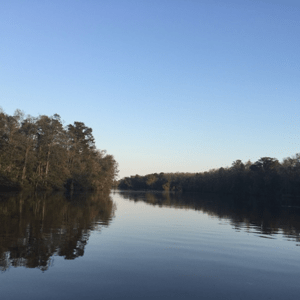
That whooshing sound you may have heard recently was your columnist checking a big item off her bucket list. I have now been down the Cape Fear River from Fayetteville to Wilmington, all 125 miles of flowing water. If seeing the Cape Fear up close and personal is on your bucket list, the trip was wonderful!
Our little band, organized by the North Carolina Civil War History Center Foundation, met on a cool Friday before 8 a.m. at Campbellton Landing in downtown Fayetteville to begin our roughly 11-hour journey. What appealed to me about this trip was Philip Gerard, a professor at the University of North Carolina at Wilmington who has not only traveled on the Cape Fear himself but has written an excellent book about his river adventures, Down the Wild Cape Fear. Philip is not only knowledgeable about the river but is a historian to boot. His series about the Civil War in North Carolina published over four years in Our State magazine focused on issues and individuals involved in our nation’s deadliest conflict, highlighted the diversity of opinion about the war within our state at the time, and reminded North Carolinians that many of the issues involved in the conflict are still issues in 2015. He also wrote the narrative that undergirds the proposed Civil War History Center.
In other words, Philip was a two-fer.
Our captain was Freddie Mims, a Fayetteville character who takes interested folks down the Cape Fear for two or four hour (and longer) cruises. Three or four times a year he goes all the way to Wilmington as we did on his large, comfy pontoon boat. Freddie is a wealth of information about the river and the history of who, what and which boats travelled it during its heyday as a commercial waterway. He also knows a thing or two about the more colorful aspects of the Cape Fear, such as sandy beach areas known as Sugar Loaf, where, Freddie declares, just as much fun has been had as at the long-gone Fox Drive-In Theater.
So off we shoved into the calm Cape Fear at Fayetteville, below two bridges and a railroad trestle crossing the water and where the banks are steep, wooded cliffs. Mist floated above the water, and I was not alone in wishing I had worn a heavier coat even though I had dressed in layers. The air warmed as the sun rose, and by the time we floated into Bladen County, we were more comfortable and a few snacks appeared. Apparently, not everyone had breakfast.
I and most others had never been through a lock, so when the first one, the William O. Huske Lock and Dam just inside Bladen County, came into view, it got our attention. Phil Edge, the longtime lockmaster who once taught me about the difficulties of fish trying to swim upstream when there is a dam, appeared to turn the wheels that operate the lock. No complicated electronics here. Basically, a lock operates like an elevator. A boat enters at one water level, gates close behind it, and Phil lets water out at the opposite end, dropping the water level to what it is below the dam, about an eight-foot drop. This is not as fast as an elevator, but it is not slow either, and we were soon back in the middle of the Cape Fear and on our way again.
Phil, who is just weeks away from retirement, met us at locks 2 and 1, in that order. The U.S. Army Corps of Engineers, which operates the locks, has cut resources significantly since commercial traffic ended on the Cape Fear in the late 1980s. As we continued toward Wilmington, the landscape changed. Gone were the cliffs at Fayetteville. The rivers banks are flatter, though still wooded, and the river widens as it became clear that we were in North Carolina’s flat coastal plain, with all traces of the hillier piedmont far behind. Remarkably, outside the lock rest areas — yes, they have clean bathrooms, my travelling buddy and I saw only one other human during our daylong journey. A teenaged boy rested his arms on the porch railing of a house. We suspect he might have been skipping school, or perhaps he is a cousin of the terrifying hillbillies in Deliverance. Our Cape Fear has its wild and woolly aspects for sure.
By the time we reached Wilmington we had all slathered on sunscreen and were down to our shirtsleeves in the waning of a perfect October day.
If this opportunity knocks on your door, go. Philip and Freddie enriched our trip immeasurably, but it is a great ride under any circumstances. And we had one last surprise---a poet in our midst and we did not even know it! Here is her rendition of our day.
“We left from the dock in Campbellton / 10 hours (125 miles) later arrived in Wilmington / Sugar Loaf and Spanish moss / Rockfish Creek — can’t get lost / Bathing turtles on cypress trees / River locks — they came in threes / Thick rich mud for beauty masks / Could make an old gator — a young lass / UNC-W professor told interesting lore / But wait — I can tell you more / A two-car ferry run by a cable / We must try it when we are able / Water, herons, sky — all blue / But oh my goodness who knew / A cruise so exotic could occur / Down the Cape Fear River

 How to resolve AdBlock issue?
How to resolve AdBlock issue? 








